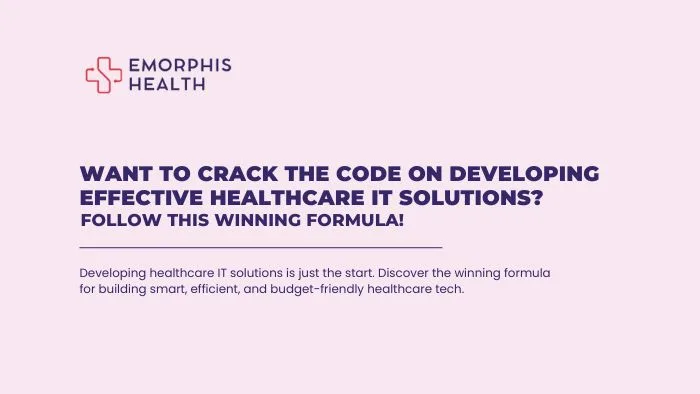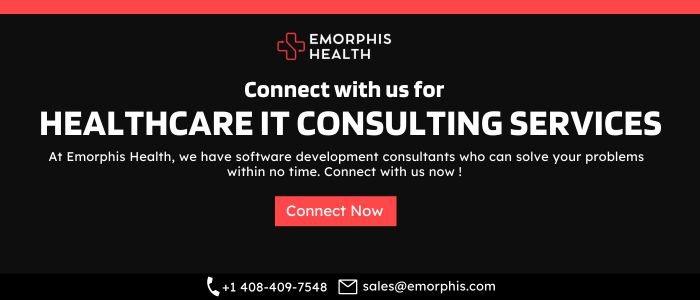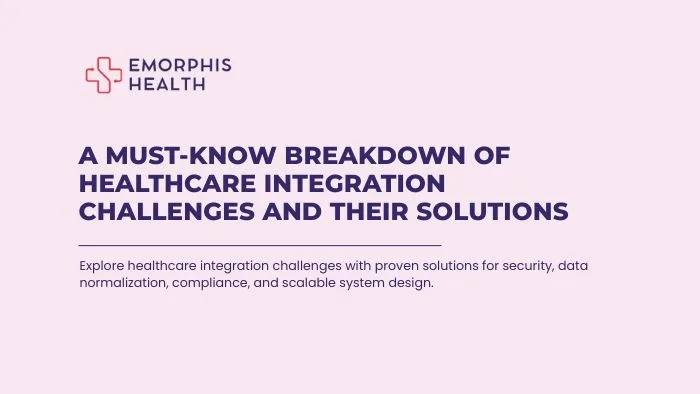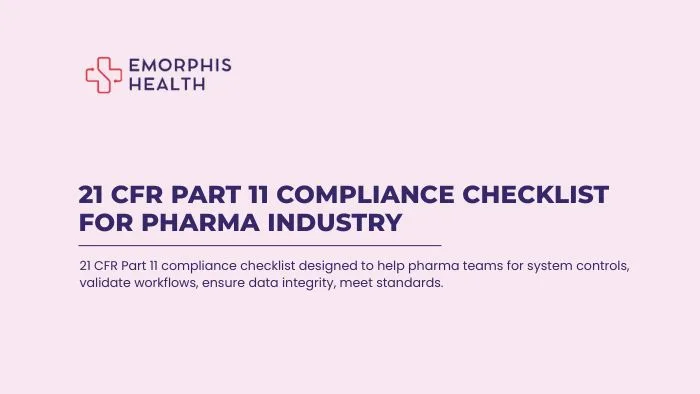Imagine a hospital investing in a new Electronic Health Record (EHR) system with advanced features, AI-driven analytics, and interoperability capabilities. The development team integrates multiple functionalities, but post-deployment, they realize that only a few features are frequently used, while the others remain underutilized. Post-launch, only 20% of features are used, revealing wasted resources. The high development and operational costs do not justify the limited return on investment, leading to financial inefficiencies and unnecessary resource expenditure.
To prevent such scenarios, organizations must ensure that their healthcare IT solutions are both efficient and financially viable. By focusing on high-impact features, automating redundant tasks, and continuously measuring performance, businesses can optimize costs and achieve long-term sustainability.
Why Measuring Cost-Effectiveness in Healthcare IT Solutions is Crucial
See Contents
- 1 Why Measuring Cost-Effectiveness in Healthcare IT Solutions is Crucial
- 2 Data-Backed Insights on the Impact and Cost-Effectiveness of Healthcare IT Solutions
- 3 How to Measure Cost-Effectiveness in Healthcare IT Solutions
- 4 Examples of Cost-Effective Healthcare IT Solutions
- 5 How Can You Win with Cost-Effective Healthcare IT Solutions?
- 6 Conclusion
Healthcare IT solutions development requires significant investment in infrastructure, compliance, and integration with existing systems. Measuring cost-effectiveness ensures:
- Maximized Return on Investment (ROI): Every investment in healthcare technology solutions should result in tangible improvements in patient care, workflow efficiency, or financial performance.
- Efficient Resource Allocation: Helps prioritize essential functionalities over redundant features, ensuring that resources are utilized optimally.
- Reduced Financial Risk: Prevents overspending on unnecessary software components and ensures alignment with the hospital’s financial goals.
- Scalability and Future Readiness: Ensures that the solution can grow without incurring exponential costs, making it a long-term asset for the healthcare facility.
Data-Backed Insights on the Impact and Cost-Effectiveness of Healthcare IT Solutions
- Reducing Readmissions with Machine Learning: A 2021 study in JAMA Network Open found that machine learning models reduced 30-day readmissions by 12–15% in a multicenter trial.
- Early Warning Systems Saving Lives: The Johns Hopkins Hospital implemented the Targeted Real-Time Early Warning System (TREWS) for sepsis, reducing mortality by 18.2% in a 2022 study.
- High Cost of Healthcare Data Breaches: IBM’s 2023 Cost of a Data Breach Report states that healthcare breaches cost $10.93M per incident—the highest of any industry.
- Remote Patient Monitoring (RPM) Reducing Readmissions: A 2020 study in NEJM Catalyst found that RPM reduced 30-day readmissions for COPD by 25% at Kaiser Permanente.
These findings highlight the critical role that healthcare IT solutions play in enhancing patient outcomes, reducing operational inefficiencies, and driving cost savings across healthcare systems. Cost-effective healthcare IT solutions are essential in achieving these goals, as they provide innovative tools that streamline processes, reduce administrative overhead, and improve the quality of care provided to patients.
Moreover, by implementing cost-effective healthcare IT solutions, healthcare providers can allocate resources more efficiently, lower the cost of medical services, and ensure that patients receive timely and accurate treatments. This approach not only supports the long-term sustainability of healthcare organizations but also contributes to better health outcomes by making high-quality care more accessible and affordable to a larger population.
Ultimately, embracing cost-effective healthcare IT solutions is key to optimizing both the operational and clinical aspects of healthcare delivery. Let’s now find out how to measure cost-effectiveness.


How to Measure Cost-Effectiveness in Healthcare IT Solutions
1. Strategic Problem Identification
Before investing in custom healthcare IT solutions, organizations should conduct a comprehensive needs analysis. This involves:
- Identifying existing inefficiencies in patient care and administrative workflows.
- Conducting stakeholder consultations with physicians, nurses, IT administrators, and hospital executives.
- Ensuring compliance with regulations like HIPAA-compliant healthcare IT solutions and interoperability standards like FHIR and HL7.
By addressing these aspects, hospitals can develop solutions that are aligned with real-world needs, ensuring both effectiveness and cost savings.
2. Iterative Prototyping and Validation
Instead of a full-scale deployment, hospitals should follow an iterative approach:
- Develop a Minimum Viable Product (MVP) to test core functionalities such as patient data management, billing integration, and telehealth capabilities.
- Gather real-time feedback from healthcare professionals to refine the system.
- Avoid costly over-engineering by focusing only on high-impact features like AI-driven healthcare analytics solutions and remote patient monitoring systems.
3. Data-driven decision-making
Using AI-driven analytics, healthcare IT consulting services can guide hospitals in making data-backed decisions. Some key insights include:
- Predictive analysis for patient readmission rates.
- Real-time monitoring of system performance and downtime.
- Identifying bottlenecks in administrative workflows.
By relying on measurable insights rather than assumptions, hospitals can minimize financial risks and ensure that their healthcare software development services are aligned with clinical and operational goals.
4. Automation for Efficiency
Automation plays a crucial role in reducing operational costs. Healthcare IT support services can leverage automation to:
- Optimize workflows, reducing manual data entry errors.
- Improve billing processes, ensuring faster reimbursement cycles.
- Enhance patient engagement through AI-powered chatbots and virtual assistants.
By automating repetitive tasks, healthcare facilities can reduce labor costs and enhance service efficiency, making their healthcare software solutions development more cost-effective.
5. Performance Metrics and Cost Analysis
After deployment, continuous measurement is crucial to assess whether custom healthcare IT solutions are delivering value. Key performance indicators (KPIs) include:
- Cost per patient acquisition (CPA) – Measures the financial efficiency of the system in attracting and retaining patients.
- Patient retention rate (PRR) – Evaluate how well the solution improves patient satisfaction and engagement.
- Operational efficiency ratio – Compares costs versus efficiency gains in administrative and clinical workflows.
- Compliance adherence – Ensures that the system meets regulatory requirements to avoid penalties and legal complications.
By tracking these KPIs, hospitals can refine their strategies and ensure long-term cost-effectiveness in healthcare technology solutions.
Examples of Cost-Effective Healthcare IT Solutions
a. Telemedicine Platforms with AI-Based Triage
Hospitals investing in cloud-based healthcare IT solutions for telemedicine can significantly cut operational costs by leveraging AI-based triage. AI chatbots can assess patient symptoms, recommend care levels, and reduce unnecessary ER visits, improving cost efficiency.
b. Automated Billing and Claims Management Systems
A hospital struggling with revenue cycle inefficiencies can implement AI-powered healthcare IT solutions to automate billing and claims management. Such systems reduce human errors, minimize denials, and improve reimbursement cycles, ensuring a more streamlined financial process.
c. Remote Patient Monitoring for Chronic Disease Management
A healthcare facility aiming to improve chronic disease management can deploy remote patient monitoring healthcare IT solutions that integrate with wearable devices. By reducing hospital readmissions, these solutions improve patient outcomes while saving costs and enhancing patient engagement.
d. AI-Powered Diagnostics and Decision Support Systems
Healthcare providers can adopt machine learning-driven healthcare IT solutions that analyze medical images and detect anomalies with high accuracy. AI-assisted diagnostics lower misdiagnosis risks and improve treatment precision, ultimately reducing healthcare costs by minimizing unnecessary tests and hospitalizations.
e. Electronic Health Record (EHR) Optimization for Better Utilization
Many healthcare organizations underutilize their EHR solutions, leading to wasted resources. Optimizing EHR usage through AI-powered recommendations, automation of routine documentation, and streamlined workflows ensures that providers maximize the benefits while controlling costs.
f. Cybersecurity Solutions to Prevent Costly Data Breaches
Given that healthcare data breaches cost an average of $10.93 million per incident, investing in advanced cybersecurity healthcare IT solutions is crucial. Solutions like AI-driven threat detection, multi-factor authentication, and blockchain-based security systems prevent breaches and save hospitals from financial and reputational losses.
g. Cloud-Based Interoperability Platforms for Seamless Data Exchange
Many hospitals face integration challenges between different IT systems. Implementing cloud-based healthcare IT solutions that enable seamless interoperability ensures smooth data sharing between EHRs, telehealth platforms, and diagnostic systems, reducing redundant tests and administrative inefficiencies.
h. Predictive Analytics for Hospital Resource Optimization
Hospitals can leverage predictive analytics healthcare IT solutions to manage bed occupancy, staff allocation, and supply chain logistics efficiently. By forecasting patient admission rates and optimizing resource distribution, healthcare facilities can significantly reduce operational costs.
i. Robotic Process Automation (RPA) for Administrative Tasks
Repetitive administrative tasks such as appointment scheduling, insurance verification, and patient record updates can be automated using RPA-driven healthcare IT solutions. By reducing manual labor and improving workflow efficiency, hospitals can lower administrative costs and enhance staff productivity.
j. Digital Therapeutics for Cost-Effective Patient Care
Hospitals and clinics can implement digital therapeutics healthcare IT solutions for conditions like diabetes, mental health disorders, and chronic pain management. These app-based interventions reduce reliance on expensive in-person treatments and provide cost-effective, scalable patient care.
By adopting these innovative healthcare IT solutions, hospitals and clinics can enhance patient outcomes, streamline operations, and maximize financial efficiency while keeping costs under control.


How Can You Win with Cost-Effective Healthcare IT Solutions?
Organizations must adopt cost-effective healthcare IT solutions to improve patient care, streamline operations, and reduce expenses. Success lies in a structured approach that ensures smart investment, agility, scalability, and continuous improvement. Here’s how healthcare providers can maximize their IT investments while maintaining financial efficiency:
i) Smart Investment Decisions: Focusing on Impactful Technologies
To ensure cost-effectiveness, healthcare organizations should prioritize IT investments that directly improve patient outcomes and operational efficiency. This means:
- Implementing AI-driven triage systems to optimize patient flow and reduce unnecessary ER visits.
- Investing in interoperable EHR solutions that enhance data sharing across departments and minimize redundancies.
- Choosing automated billing and revenue cycle management tools to reduce claim denials and administrative overhead.
ii) Agile Methodologies: Adapting to Industry Changes Efficiently
Healthcare technology needs to be flexible enough to adapt to regulatory updates, emerging medical trends, and evolving patient needs. By adopting agile methodologies, healthcare providers can:
- Quickly implement telehealth solutions without major infrastructure overhauls.
- Test and refine remote patient monitoring (RPM) programs based on real-world performance.
- Make incremental updates to cybersecurity frameworks to keep up with rising threats.
iii) Scalability Planning: Ensuring Long-Term Growth
A healthcare IT solution must grow alongside the organization to remain cost-effective. This requires designing systems that can:
- Seamlessly expand telemedicine capabilities to accommodate growing patient demand.
- Integrate with wearable health devices for real-time patient monitoring.
- Support predictive analytics tools that improve hospital resource management.
iv) Continuous Improvement: Keeping Systems Optimized
Healthcare IT systems should evolve based on user feedback, regulatory changes, and technological advancements. Organizations can achieve this by:
- Conduct regular system audits to identify inefficiencies.
- Implementing machine learning-driven diagnostics to enhance accuracy and reduce misdiagnoses.
- Updating data security protocols to prevent costly breaches and compliance violations.
Conclusion
Developing cost-effective healthcare IT solutions is not just about cutting costs but about maximizing value. By implementing strategic planning, data-driven decision-making, and continuous optimization, healthcare organizations can create impactful solutions that optimize workflows, enhance patient care, and ensure financial sustainability.
Further, check with healthcare IT consulting services and explore how they can improve operational efficiency also drive better patient outcomes while maintaining cost-effectiveness in the long run.






